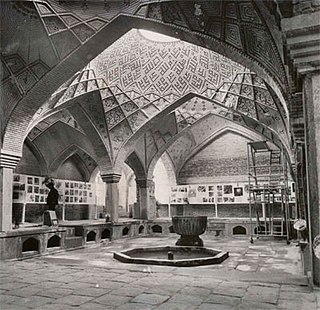 W
WPublic baths originated at a time when most people in population centers did not have access to private bathing facilities. Though termed "public", they have often been restricted according to gender, religious affiliation, personal membership, and other criteria. In addition to their hygienic function, public baths also have served as social meeting places. They have sometimes included saunas, massages, and other relaxation therapies, such as are found in modern day spas. As the percentage of dwellings with private bathrooms has increased in some societies, the need for public baths has diminished, and they are now almost exclusively used for recreational purposes.
 W
WThe Albergo diurno Venezia is a structure built under Piazza Oberdan in Milan, on the western side towards Via Tadino.
 W
WThe first reports of bathing in Yangzhou originated before 200 BC. In Yangzhou, Jiangsu, China. Locals bathe by filling up pots with water. In ancient Yangzhou natives from the Han Dynasty until the Tang Dynasty bathed at home. Public baths were not available.
 W
WThe Great Bath is one of the best-known remarkable structures among the ruins of the ancient Indus Valley Civilization excavated at Mohenjo-daro in Sindh, Pakistan. Archaeological evidence indicates that the Great Bath was built in the 3rd millennium BCE, soon after the raising of the "citadel" mound on which it is located.
 W
WThe Jarchi hammam or Jarchibashi hammam is a historical structure in Isfahan, Iran.The hammam belongs to the safavid era. It is located in the Hakim street.
 W
WA jjimjilbang is a large, sex-segregated public bathhouse in South Korea, furnished with hot tubs, showers, Korean traditional kiln saunas and massage tables. Jjimjil is derived from the words meaning heating. In other areas of the building or on other floors there are unisex areas, usually with a snack bar, ondol-heated floor for lounging and sleeping, wide-screen TVs, exercise rooms, ice rooms, heated salt rooms, PC bang, noraebang, and sleeping quarters with bunk beds or sleeping mats. Many of the sleeping rooms have themes or elements to them. Usually jjimjilbangs will have various rooms with temperatures to suit guests' preferred relaxing temperatures. The walls are decorated with woods, minerals, crystals, stones, and metals to make the ambient mood and smell more natural. The elements used have traditional Korean medicinal purposes in the rooms.
 W
WThe Khosro Agha hammam was a historical hammam in Iran. It was located in the Sepah street in Isfahan and belonged to the Safavid era.
 W
WSandunóvskie Baths or Sanduný is a cultural and architectural landmark in downtown Moscow, located at 14 Neglinnaya street adjacent to the Central Bank of Russia. First opened in 1808, the baths were founded by and named after the Georgian businessman Sila Sandunov (Zandukeli) (1756–1820), who was once an actor at the court of Catherine II during the 1790s. He bought a land plot on the Neglinnaya River in 1800 to construct baths there.
 W
WThe Shahi Hammam, also known as the Wazir Khan Hammam, is a Persian-style bath which was built in Lahore, Pakistan, in 1635 C.E. during the reign of Emperor Shah Jahan. It was built by chief physician to the Mughal Court, Ilam-ud-din Ansari, who was widely known as Wazir Khan. The baths were built to serve as a waqf, or endowment, for the maintenance of the Wazir Khan Mosque.
 W
WGotha Public Baths is a listed historical building of the Art Nouveau era. Centrally located on the northern fringes of Gotha’s old town, it was completed in 1909. After prolonged use, the original building was closed in the 1980s due to its dilapidated state. In 2007 the baths underwent a thorough restoration, modernisation and expansion programme, the resultant surface area being more than twice that of the original building. The baths were reopened in 2014.
 W
WTtaemiri are the working staff who provide many services at the Jjimjilbang in South Korea.
 W
WThe Turkish Bath is an oil painting by Jean-Auguste-Dominique Ingres, initially completed between 1852 and 1859, but modified in 1862. The painting depicts a group of nude women at a pool in a harem. It has an erotic style that evokes both the Near East and earlier western styles associated with mythological subject matter. The painting expands on a number of motifs that Ingres had explored in earlier paintings, in particular The Valpinçon Bather (1808) and La Grande odalisque (1814).
 W
WThe Turkish Baths was a Victorian Turkish bath on Lincoln Place, Dublin.
 W
WVictorian Turkish bath or simply Turkish bath is a type of public bathhouse which was derived from the hammam (bathhouse) of the Islamic world and those Roman baths which used hot dry air. It became popular as a therapy, a method of cleansing, and a place for relaxation during the Victorian era, rapidly spreading through the British Empire, the United States of America, and Western Europe.
 W
WPierre Vigier was a French magistrate.